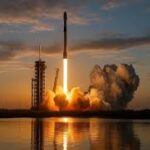The National Aeronautics and Space Administration (NASA) is more than just a space agency; it’s a symbol of human curiosity, scientific advancement, and international collaboration. Founded in 1958 by the United States government, NASA has revolutionized our understanding of the universe and pushed the boundaries of what humanity can achieve in space and beyond.
From landing astronauts on the Moon to exploring distant planets and launching powerful space telescopes, NASA’s influence stretches across the globe. Its missions have inspired generations of scientists, engineers, dreamers, and everyday citizens who look to the skies and wonder what lies beyond. This article delves into NASA’s incredible journey, its global partnerships, and the future it envisions for humanity among the stars.
The Origins of NASA
NASA was established in response to the Soviet Union’s launch of Sputnik 1, the first artificial satellite, in 1957. This event marked the beginning of the Space Race, prompting the United States to invest heavily in space exploration. NASA officially opened for business on October 1, 1958, with a mission to expand human knowledge through the exploration of space.
Initially, NASA inherited programs from its predecessor, the National Advisory Committee for Aeronautics (NACA). However, it quickly developed its own ambitious goals. Early milestones included the Mercury and Gemini programs, which paved the way for the Apollo program and the historic Moon landing in 1969.
The Apollo Moon Missions
One of NASA’s most defining achievements came on July 20, 1969, when Neil Armstrong and Buzz Aldrin became the first humans to walk on the Moon during Apollo 11. The iconic phrase, “That’s one small step for man, one giant leap for mankind,” echoed around the world, symbolizing the limitless potential of science and exploration.
Between 1969 and 1972, a total of six Apollo missions successfully landed on the Moon, allowing astronauts to conduct experiments, collect lunar samples, and demonstrate the feasibility of human space travel.
Space Shuttles and the International Space Station (ISS)
The shuttle fleet enabled hundreds of astronauts to travel to space and launched vital satellites, scientific instruments, and even components of the International Space Station (ISS).
The ISS, a joint project involving NASA, Russia’s Roscosmos, European Space Agency (ESA), Japan’s JAXA, and Canada’s CSA, represents one of the most significant examples of international cooperation in history.
Mars Missions and Planetary Exploration
Mars has always fascinated scientists, and NASA has led the way in exploring the Red Planet. From the Viking missions in the 1970s to the highly advanced Perseverance rover that landed in 2021, NASA has consistently delivered data that sheds light on Mars’ climate, geology, and potential for life.
The Mars 2020 mission, featuring Perseverance and the Ingenuity helicopter, demonstrated technologies that will be vital for future human missions. Ingenuity made history by performing the first powered flight on another planet, a true milestone for robotic space exploration.
Beyond Mars, NASA has explored the entire solar system. Missions like Cassini (to Saturn), Juno (to Jupiter), and New Horizons (to Pluto) have transformed our understanding of these distant worlds.
Space Telescopes and Deep Space Observation
NASA’s reach extends far beyond the solar system thanks to space telescopes like the Hubble Space Telescope, launched in 1990. Hubble has captured breathtaking images of galaxies, nebulae, and black holes, helping astronomers unravel the mysteries of the universe.
In December 2021, NASA launched the James Webb Space Telescope (JWST), a powerful observatory designed to look deeper into the cosmos than ever before. JWST is already delivering stunning images and is expected to answer profound questions about the origins of stars, galaxies, and even life.
Earth Sciences and Climate Monitoring
While NASA is known for space exploration, it also plays a crucial role in monitoring Earth’s environment. Through its fleet of Earth-observing satellites, NASA gathers data on climate change, sea-level rise, deforestation, natural disasters, and weather patterns.
Programs like Landsat, Aqua, and Terra provide open-source data that support scientists, governments, and humanitarian organizations around the world. By understanding our planet better, NASA helps ensure a more sustainable future for all.
Innovations and Technology Transfer
NASA’s technological innovations have benefited people around the world through its Technology Transfer Program. Many everyday technologies originated from NASA research, including:
- Memory foam
- Infrared thermometers
- Water purification systems
- Anti-icing systems for aircraft
- Satellite-based GPS enhancements
These innovations show how space exploration drives practical solutions to real-world problems.
International Collaboration
NASA’s work is increasingly global. In addition to partnerships on the ISS, NASA collaborates with countries like India, the UAE, Israel, and South Korea on satellite launches, space science, and educational initiatives.
One major example is the Artemis program, which aims to return humans to the Moon and eventually send astronauts to Mars.
NASA’s Vision for the Future
NASA’s long-term vision is bold: return to the Moon, land humans on Mars, and search for signs of life elsewhere in the universe. The Artemis missions, including the upcoming crewed mission Artemis III, will feature the first woman and person of color to walk on the lunar surface.
Education and Inspiration
One of NASA’s most powerful impacts is its ability to inspire. Through programs like NASA STEM Engagement, the agency encourages young people around the world to pursue careers in science, technology, engineering, and mathematics (STEM). Educational resources, internships, public outreach events, and open data platforms make NASA’s work accessible and exciting for all.
Conclusion
Over the past six decades, it has expanded our understanding of the cosmos while making life better here on Earth. With bold missions on the horizon and a continued commitment to discovery, NASA continues to unite humanity under a shared dream: reaching for the stars.



